
‘Seaweed cement could shrink concrete’s CO₂ footprint’
Researchers from the University of Washington (UW) and Microsoft have developed a new type of low-carbon concrete by mixing dried seaweed powder with cement. The seaweed-enhanced cement has a 21 percent lower global warming potential, yet maintains the same strength as conventional concrete. Thanks to machine learn ing models, the team arrived at this new formula in a fraction of the time traditional research would require. Innovatieve Materialen (Innovative Materials) is a digital, independent magazine about material innovation in the fields of engineering, construction (buildings, infrastructure and industrial) and industrial design.
Low-settlement equilibrium foundations
Schiedam-Noord has been used as a sludge depot for several decades since the 1960s. In the 1990s, the site was prepared for the planned housing development by preloading it with 2.70 m of sand. However, this proved unstable, resulting in significant settlement. Within ten years, the neighborhood was subsequently raised several times without any insight into the final settlement. Due to the severe settle ment, raising the site was necessary to achieve a tax-neutral or tax-reducing effect. Three suitable options exist: EPS, glass foam, and foam concrete.
Living building material that stores carbon
At ETH Zurich, researchers from various disciplines are working on new materials that combine conventional raw materials with bacteria, algae, and fungi. Their goal is to develop living materials that, thanks to the metabolism of microorganisms, pos sess beneficial properties, such as capturing CO₂ from the air through photosynthe sis. The result is a (building) material that lives, grows, and actively absorbs carbon from the atmosphere.
Rainproof facade panels made from walnut shells
Can food waste streams be used as building materials? This question was central to Lara Neuhaus’s graduation project, ‘Bio-composites from food waste.’ She developed a biobased composite made from walnut shells. Initial material tests show promising results. With her research, she also aims to contribute to a change in the way we view materials: appreciating imperfections in color and texture can pave the way for more sustainable innovations.
Studying Porous Materials with AI
Advances in artificial intelligence for designing porous materials could impact a wide range of fields, from orthopedic implants to next-generation batteries.









